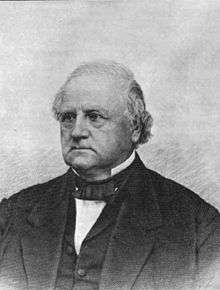Edward Kent
| Edward Kent | |
|---|---|
 Edward Kent | |
| 15th Governor of Maine | |
|
In office January 13, 1841 – January 5, 1842 | |
| Preceded by | Richard H. Vose |
| Succeeded by | John Fairfield |
| 12th Governor of Maine | |
|
In office January 19, 1838 – January 2, 1839 | |
| Preceded by | Robert P. Dunlap |
| Succeeded by | John Fairfield |
| Member of the Maine Senate | |
|
In office 1831–1833 | |
| 2nd Mayor of Bangor, Maine | |
|
In office 1836–1837 | |
| Preceded by | Allen Gilmam |
| Succeeded by | Rufus Dwinel |
| Personal details | |
| Born |
January 8, 1802 Concord, New Hampshire, U.S. |
| Died |
May 19, 1877 (aged 75) Bangor, Maine, U.S. |
| Resting place | Mount Auburn Cemetery in Cambridge, Massachusetts. |
| Political party | Whig |
Edward Kent (January 8, 1802 – May 19, 1877) was the 12th and 15th Governor of the U.S. state of Maine during the Aroostook War.
Biography
Born in 1802 in Concord, New Hampshire, he later moved to Bangor, Maine and spent the rest of his life there. He was among the last prominent members of the Whig Party in Maine before it collapsed in favor of the Republicans. He is the only Maine governor to have been elected to two non-consecutive terms (1838–39 and 1841–42), though his second term was through direct appointment by the Whig-dominated legislature.
Kent graduated from Harvard in 1821, in the same class as Ralph Waldo Emerson. According to a biographical article reprinted in the New York Times, "he had no rank in college and in truth was President of the 'Lazy Club'. He apprenticed as a lawyer in Topsham, Maine, but established his own practice in the growing lumber-port of Bangor in 1825. He was elected to the Maine Legislature in 1829 and held political offices on and off the rest of his life, becoming the 2nd Mayor of Bangor (1836–37), then Governor, and then U.S. Consul in Rio de Janeiro (1849–53). Tragedy struck him in Rio when two of his three children, along with his wife Sarah Johnston (the daughter of Nathaniel Johnston of Hillsborough, NH) died of yellow fever. His surviving child died soon after they returned to Bangor. Kent married a second time, to Abigail Ann Rockwood who was the niece of first wife Sarah Johnston, and had one more child, Edward Kent, Jr., who became the Chief Justice of the Arizona Territory Supreme Court.[1]
Kent went into practice with Jonas Cutting in 1831 and their partnership lasted 18 years. The two even built a double house together, in Bangor's Broadway neighborhood, which is listed on the National Register of Historic Places as a unique example of the Greek Revival style.[1]
Kent ended his public life as an Associate Justice of the Maine Supreme Judicial Court (1859–73). His law partner and neighbor Jonas Cutting served almost concurrently in the same position (1854–75). Kent's uncle Prentiss Mellen had been the first Chief Justice of the same court.
Kent played a part in both instigating and resolving the Aroostook War. Fort Kent, situated where the Fish River meets the Saint John River in the Saint John River Valley, was named in his honor. Later, the town of Fort Kent, Maine[2] was named for the military installation (of which only a single blockhouse survives) and for Governor Kent. He died of congestive heart failure in 1877 in Bangor, Maine, and is buried at the Mount Auburn Cemetery in Cambridge, Massachusetts.
References
- 1 2 "Edward Kent: Anecdotes of the Governor for Whom Maine Went", New York Times, Dec. 4, 1881, p. 2; Henry Chase, "Edward Kent", Representative Men of Maine (Portland, 1893)
- ↑ Gannett, Henry (1905). The Origin of Certain Place Names in the United States. Govt. Print. Off. p. 129.
Further reading
- David M. Gold. An Exemplary Whig: Edward Kent and the Whig Disposition in American Politics and Law (Lexington Books; 2012) 255 pages; scholarly biography
| Political offices | ||
|---|---|---|
| Preceded by Robert P. Dunlap |
12th Governor of Maine 1838–1839 |
Succeeded by John Fairfield |
| Preceded by John Fairfield |
15th Governor of Maine 1841–1842 |
Succeeded by John Fairfield |
| Preceded by Allen Gilmam |
2nd Mayor of Bangor, Maine 1836–1837 |
Succeeded by Rufus Dwinel |
| Legal offices | ||
| Preceded by Joshua W. Hathaway |
Associate Justice of the Maine Supreme Judicial Court 1859–1873 |
Succeeded by John A. Peters |
